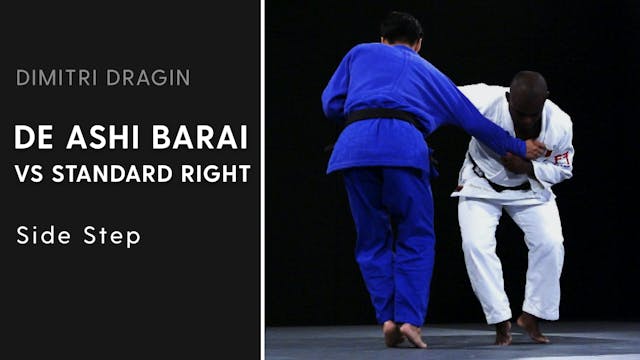Here is Dimitri Dragin’s De Ashi Barai from a standard right vs right position.
Of all of Dragin’s De Ashi Barai variations this was his most successful.
It’s a perfect example of what Dragin’s Judo is all about.
Using his whole body to apply pressure onto his opponent, getting a reaction and then capitalising on it to execute a technique.
Like with all of Dragin’s De Ashi Barai variations he starts off looking for the De Ashi, but sometimes, depending on how Uke moves as Dragin makes contact, it can end up as Okuri Ashi Barai instead.
Either way this was an extremely successful scoring technique for Dragin, and one his opponents feared.
Even though they knew it was his Tokui Waza, Dragin could still catch just about anyone with it.
The setup was designed to trick his opponents into thinking a forward attack was coming, so they would move in the opposite direction to avoid the potential attack.
Then Dragin would strike, catching them by surprise.
Next Dimitri Dragin will teach you step by step how his De Ashi Barai against standard right works, from the set up to the execution.
Then we will then get to see it in action in competition at the World’s biggest tournaments.
Up Next in Dimitri Dragin
-
Set Up | De Ashi Barai VS Standard Ri...
Dragin’s De Ashi Barai in a standard right vs right situation, is off the Sleeve and high lapel grip.
Dragin starts by bunching up the sleeve, making sure he has a strong grip on it.
He uses this grip to build the tension on his opponent’s arm.
Then pulls the sleeve down and across the front ...
-
Side Step | De Ashi Barai VS Standard...
When Uke starts to move, Dragin makes sure he keeps his lapel hand relaxed, while gripping tightly with his sleeve hand
He also needs to continue to apply his bodyweight down onto Uke’s arm.
It’s crucial however that he doesn't put too much pressure down onto the arm, as this could break their ...
-
Execution | De Ashi Barai VS Standard...
To execute the throw, Dragin wants to attack as Uke’s legs start to move towards each other.
He wants to use the base of his foot to make contact, keeping his leg slightly bent.
He doesn’t mind whether he connects with one leg, De Ashi, or 2, Okuri Ashi. In both sce-narios he drives his leg th...




1 Comment